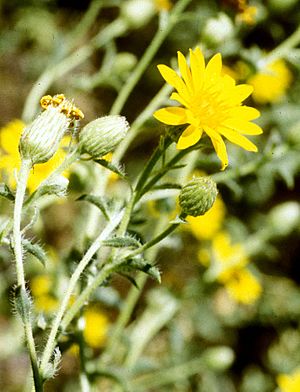Kern Canyon false goldenaster facts for kids
Quick facts for kids Kern Canyon false goldenaster |
|
|---|---|
 |
|
| Conservation status | |
| Scientific classification | |
| Kingdom: | |
| (unranked): | |
| (unranked): | |
| (unranked): | |
| Order: | |
| Family: | |
| Tribe: |
Astereae
|
| Genus: |
Heterotheca
|
| Species: |
H. shevockii
|
| Binomial name | |
| Heterotheca shevockii (Semple) Semple 1996
|
|
| Synonyms | |
|
|
Heterotheca shevockii is a special kind of flowering plant. It is part of the aster family, which includes sunflowers and daisies. People also call it the Kern Canyon false goldenaster or Shevock's goldenaster.
This plant is very rare and only grows in one specific place. It is endemic to California in the United States. You can only find it in Kern County, along a 21-mile (about 34-kilometer) stretch of the Kern River.
Contents
What Does Heterotheca shevockii Look Like?
Heterotheca shevockii is a perennial herb. This means it is a plant that lives for more than two years. It grows back each year from its roots.
Plant Size and Stems
This plant can grow quite tall, from about 28 to 131 centimeters (11 to 52 inches) high. It often has many stems that stand straight up. These stems can feel a bit rough because they are covered in hairs or bristles.
Leaves and Flowers
The leaves of the Kern Canyon false goldenaster are shaped like a spear, which is called "lance-shaped." They can be up to 6.5 centimeters (2.6 inches) long and 1.6 centimeters (0.64 inches) wide.
The plant produces many flower heads. An inflorescence is a group or cluster of flowers arranged on a stem. Each plant can have anywhere from 3 to 70 flower heads. These heads grow on hairy stems called peduncles.
Flower Head Details
Each flower head looks like a small sunflower. It has two main parts:
- Ray florets: These are the yellow, petal-like parts around the edge. There can be up to 18 of these, each about one centimeter long.
- Disc florets: These are the many tiny flowers packed together in the center of the head.
Fruit and Flowering Time
After the flowers bloom, the plant produces a fruit called an achene. An achene is a small, dry fruit that contains one seed, like a sunflower seed. The achene of this plant can be over a centimeter (0.4 inches) long. It also has a feathery top called a pappus, which helps the seed float away in the wind.
Heterotheca shevockii usually blooms in August and September. However, you might see its yellow flowers at other times, from January all the way to November.
Where Does Heterotheca shevockii Live?
This rare plant prefers to grow in specific types of habitats. It is found in chaparral and woodland areas. Chaparral is a type of shrubland common in California, with tough, woody plants.
The plant likes sandy soils. You can often find it growing in small cracks in rocks or in ditches near the Kern River.
How Many Plants Are Left?
Because it is so rare, scientists keep track of how many Heterotheca shevockii plants exist. There are only about 8 known groups, or "populations," of this plant. Together, these groups have a total of about 246 individual plants. This small number makes it a very important species to protect.


